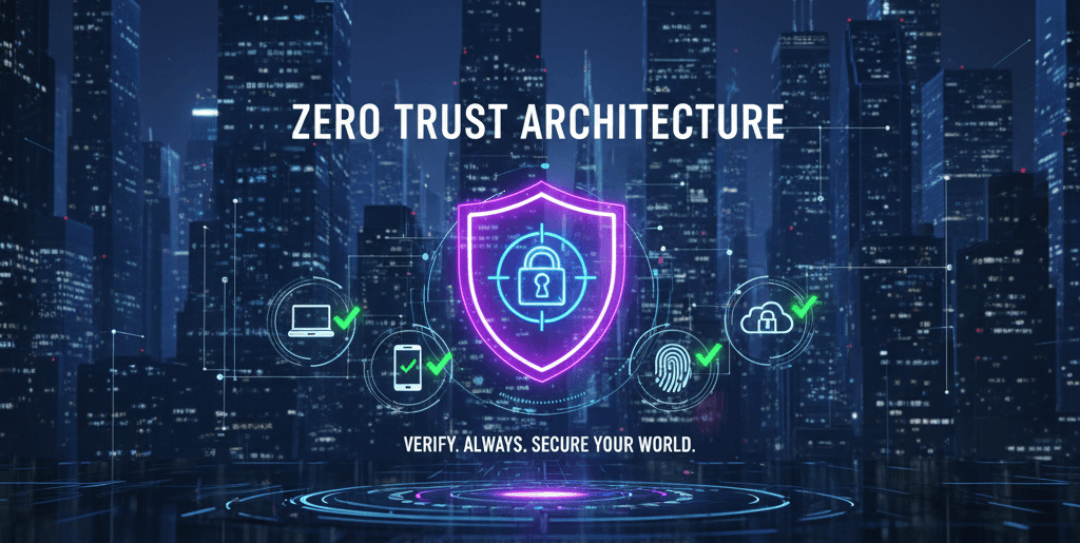Zero Trust Architecture: The Future of Cybersecurity for UAE Businesses
In today’s digital world, the way we work has changed dramatically. Employees, partners, and business apps now operate across remote locations, public networks, and the cloud. This technological evolution has fundamentally rendered the traditional network perimeter model obsolete. Consequently, this shift has led to a critical cybersecurity trend: Zero Trust Architecture. But what is it, and why is it essential for securing and growing your business in the UAE?
Simply put, Zero Trust operates on the principle of “never trust, always verify.” This model immediately discards the outdated idea of implicit trust for entities inside the network, operating instead on the assumption that threats exist both externally and internally at all times. Therefore, it requires strict, continuous verification for every user and device trying to access resources, regardless of their location. This proactive and vigilant approach is rapidly becoming the new standard for securing a modern business.
Why the Old Security Model is Broken
For years, businesses relied on a “castle-and-moat” security model. They built a strong firewall (the moat) to protect everything inside their office network (the castle). If you worked inside the office on a company desktop, the system automatically trusted you. The primary focus was on keeping attackers out.
However, this model is no longer effective in a world where business operations are decentralized. With the widespread adoption of remote work, cloud services like Microsoft 365, and Bring-Your-Own-Device (BYOD) policies, there is no longer a clear “inside” and “outside.” A single compromised password or an insecure Wi-Fi connection can give an attacker a trusted entry point. As a result, this single point of failure allows attackers to bypass perimeter controls and move laterally to access mission-critical systems.
The Core Principles of Zero Trust Security
Moving away from implicit trust, Zero Trust Architecture builds a robust, resilient defense. Specifically, it adheres to three fundamental principles:
1. Verify Explicitly:
Zero Trust treats every access request as a potential threat. It requires strong authentication—typically multi-factor authentication (MFA), not just a password. This confirms the user’s identity every time they access an application or data. This verification also considers other signals, like the user’s location and the security health of their device. Crucially, verification is continuous throughout the session, adapting to risk signals.
- Example: A user trying to log in from a new country (e.g., outside the UAE) triggers an MFA prompt, which a thief without the phone cannot answer.
2. Use Least Privilege Access:
Grant users only the minimum access they absolutely need to perform their jobs. For example, a marketing team member should not have access to financial records. This principle dramatically limits potential damage if an account is compromised. In effect, it contains the attacker’s movement to a small, isolated area.
- Example: Even if a sales account is compromised, the attacker cannot access the HR database because access is explicitly denied by Zero Trust’s default-deny policy.
3. Assume Breach:
Zero Trust operates with the understanding that a breach is not a matter of “if,” but “when.” This mindset shifts the security focus from prevention alone to include rapid detection, analysis, and response. This means having systems in place to spot unusual activity quickly and minimize the impact of any potential attack, ensuring business continuity.
- Example: If a workstation shows suspicious file encryption activity (a ransomware indicator), the system automatically isolates it from the network instantly.
What Does Zero Trust Look Like in Practice?
Implementing Zero Trust isn’t about buying a single product; it’s a comprehensive strategy that integrates several technologies and policies. By combining these technologies and principles, your business gains a powerful defense against modern cyber threats. To illustrate, here are a few practical examples of what it involves:
- Multi-Factor Authentication (MFA): As the cornerstone of Zero Trust, MFA requires users to provide two or more verification factors—like a password plus a one-time code from a mobile app—to prove their identity. In a real-world scenario, MFA frequently halts sophisticated phishing and credential stuffing attacks by requiring a secondary token.
- Endpoint Security: Furthermore, Endpoint Security ensures every connecting device (laptops, phones) is secure, up-to-date, and continuously monitored. The system only grants access after checking for threats. Advanced endpoint protection can prevent ransomware from executing if suspicious behavior is detected.
- Network Micro-segmentation: Finally, this practice involves breaking your network into smaller, isolated zones. If one segment is compromised, these digital barriers prevent an attacker from moving freely across your other critical systems, effectively containing the threat.
How 800ITCare Can Help You Adopt Zero Trust
Transitioning to a Zero Trust model can seem complex, but you don’t have to do it alone. Therefore, a knowledgeable IT partner is essential to guide you through the entire process, from initial assessment to full implementation and ongoing management.
At 800ITCare, we help UAE businesses:
- Assess your security posture with a full IT audit to identify vulnerabilities and map out critical data flows.
- Formulate a Strategic Roadmap: We develop a Zero Trust strategy tailored to your specific regulatory and operational needs, prioritizing risk reduction for immediate security improvements.
- Implement core tools like MFA, Identity and Access Management (IAM), and advanced device monitoring.
- Provide 24/7 managed security support to continuously monitor, detect, and respond to threats.
👉 Contact us today to schedule your Zero Trust readiness assessment.
Secure Your Business for the Future
Zero Trust is more than just a buzzword; it’s the future of cybersecurity and a fundamental strategy for business resilience. By adopting this forward-thinking approach, you can build a more secure and agile business. Moreover, Zero Trust adoption enables robust business continuity and provides a critical competitive advantage in the digital marketplace.
Ready to strengthen your cybersecurity? Contact 800ITCare today to schedule your Zero Trust audit and secure your future.


